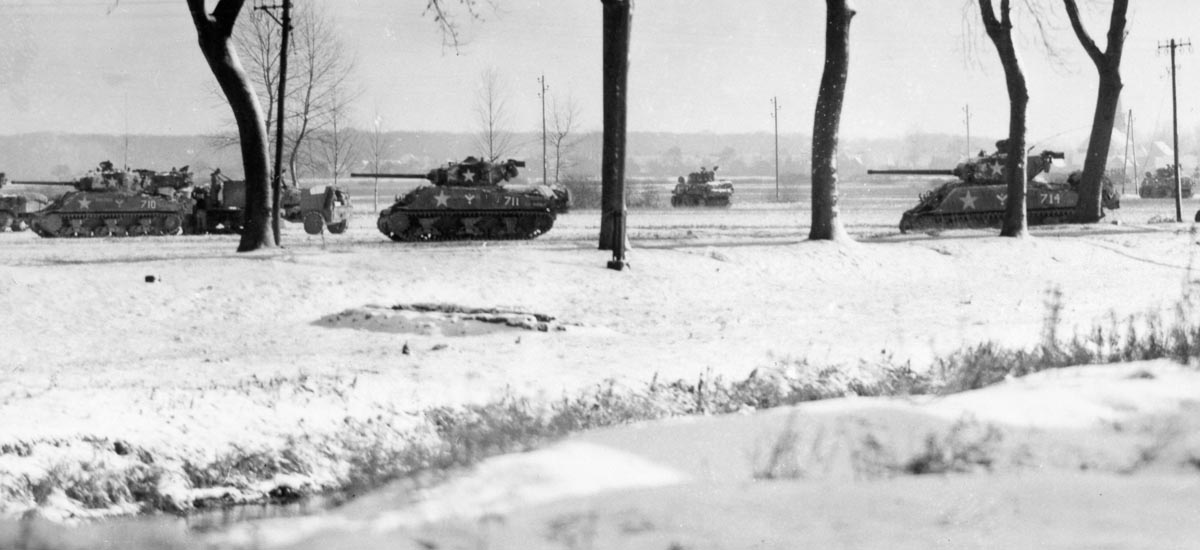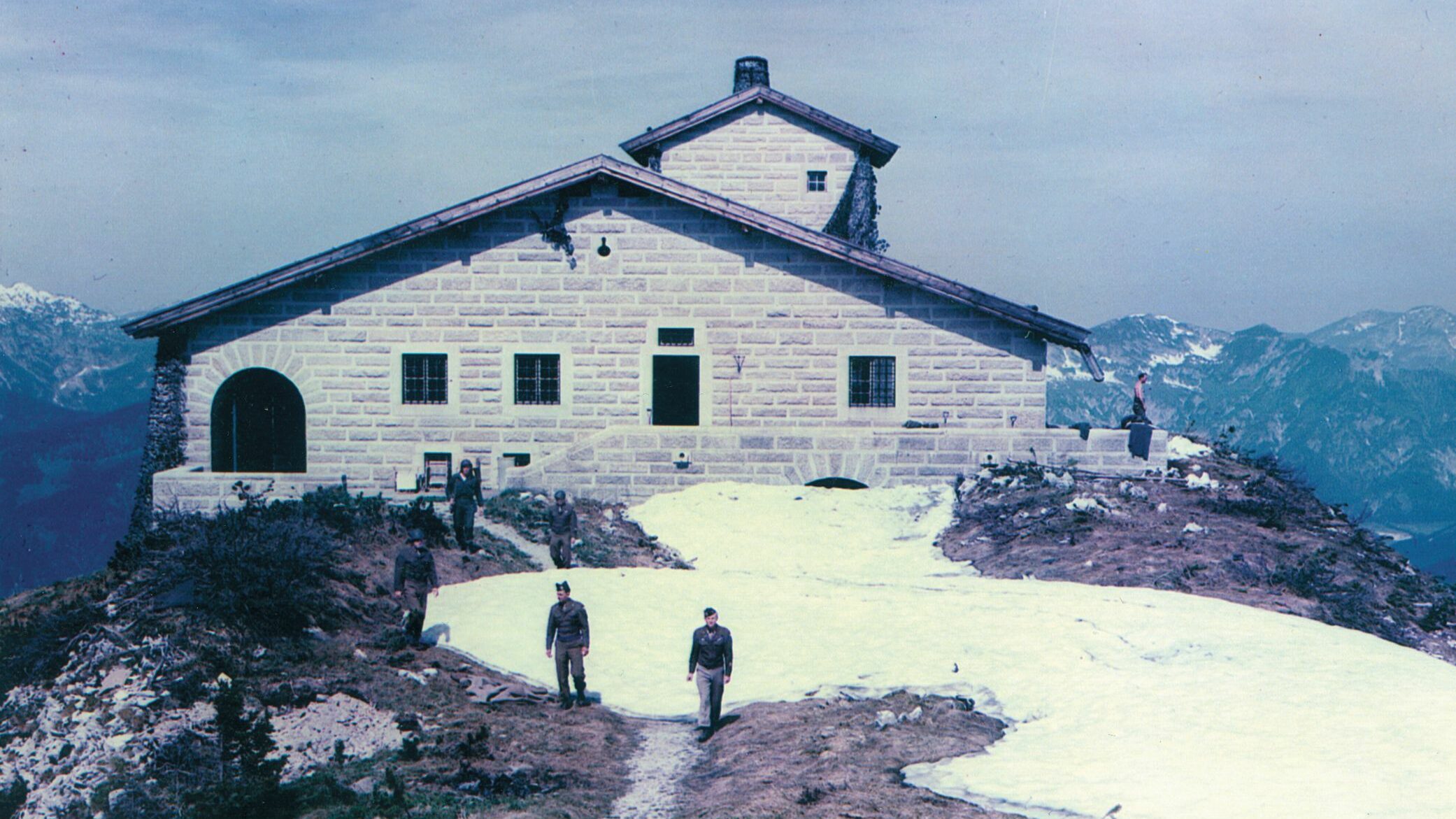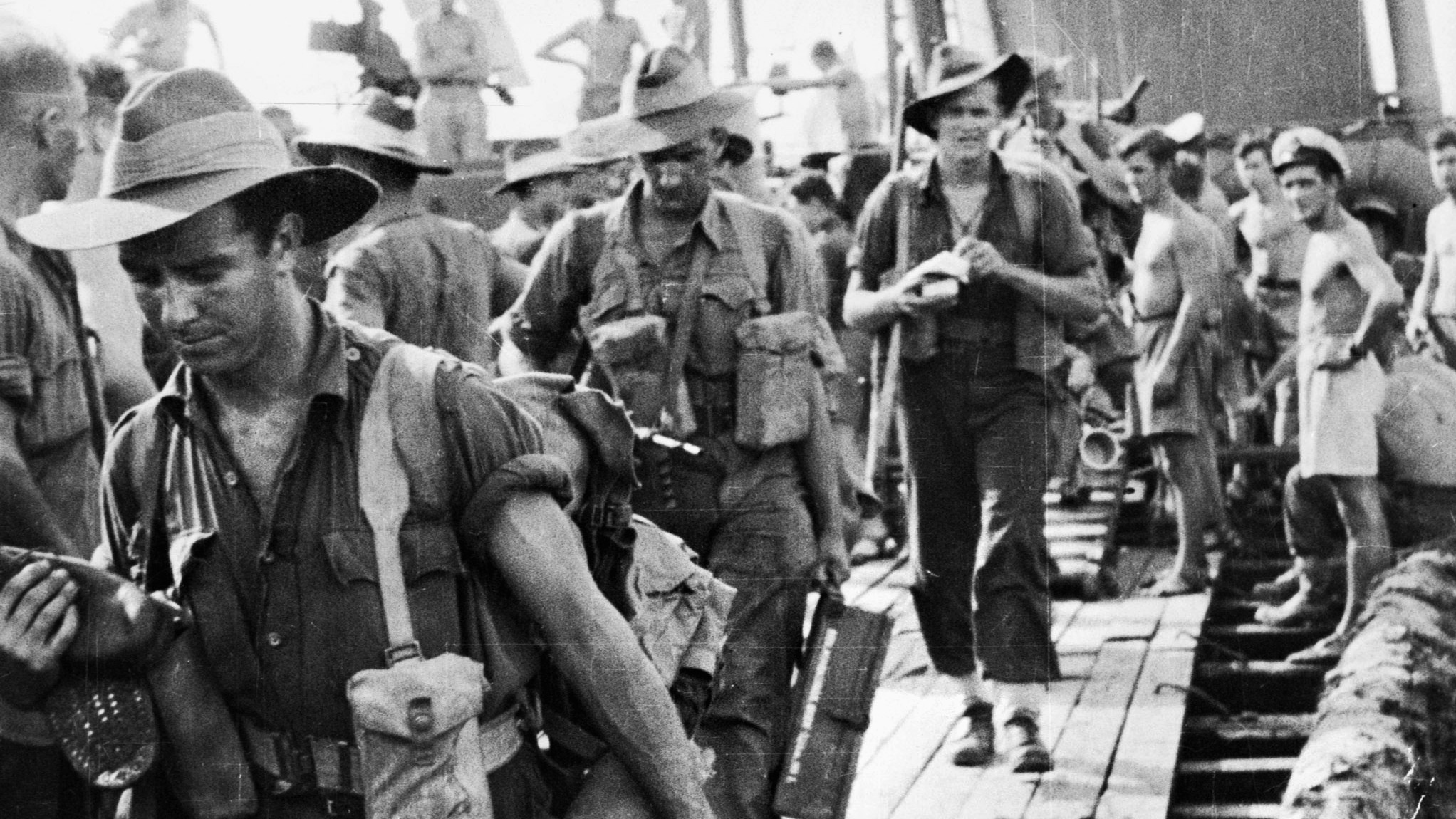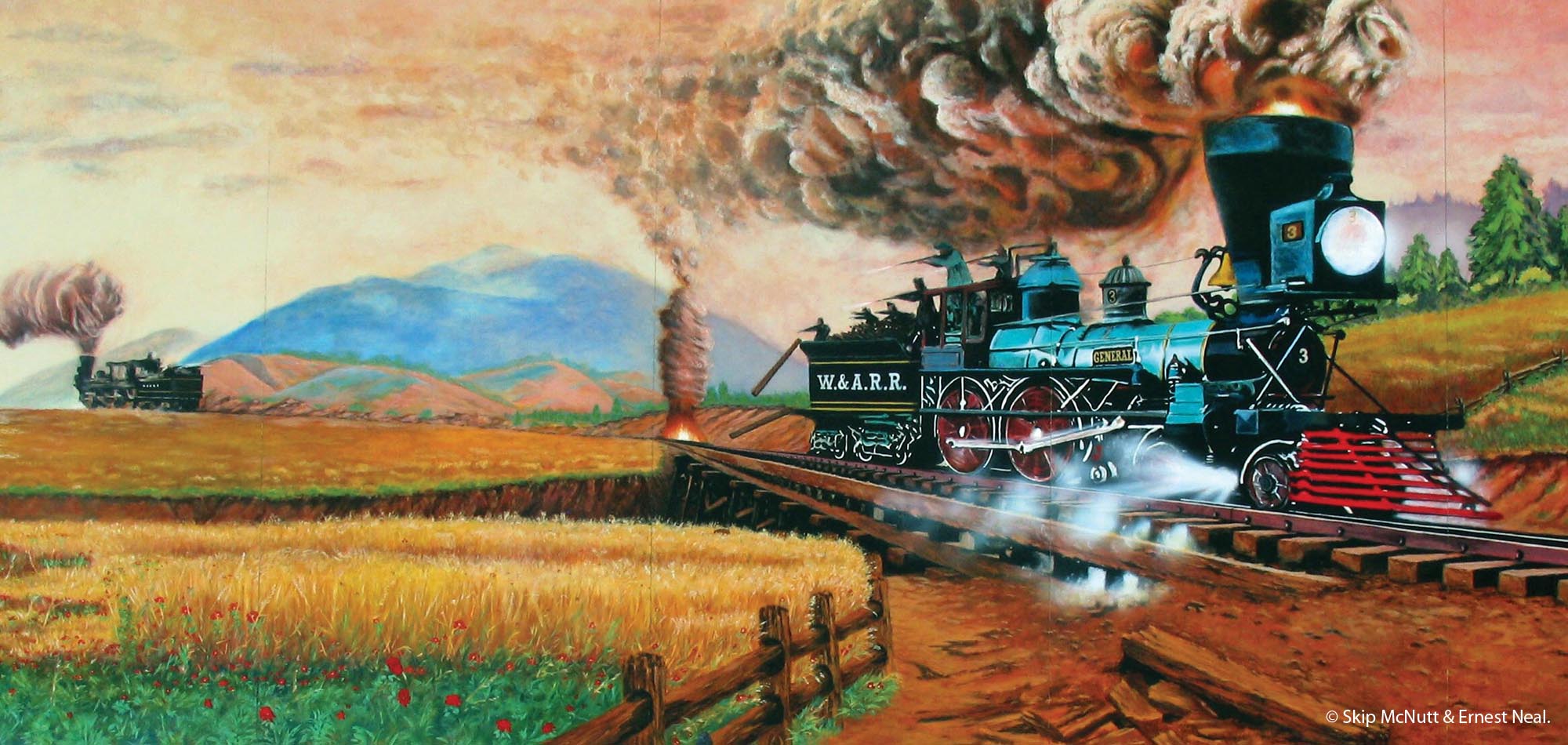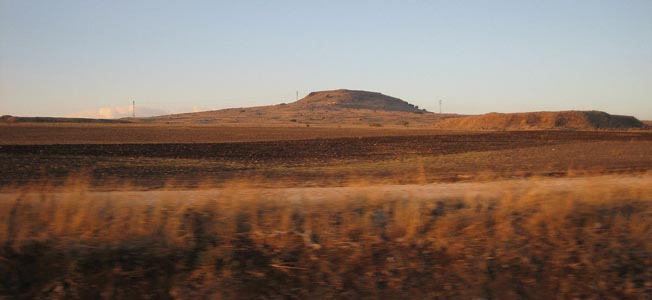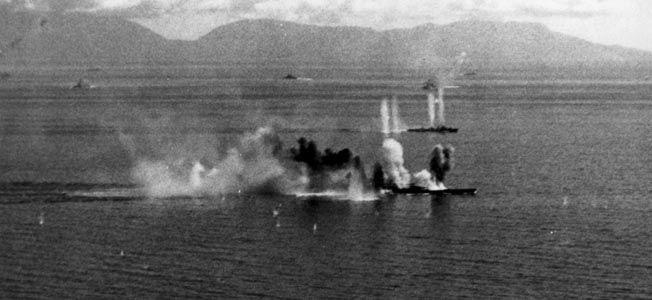By Allyn Vannoy
The American light tanks, bringing up much needed supplies, were in column as they began to take fire. When the second in line was hit, the crew bailed out except for the driver, whose head had been blown off. But the damaged vehicle was blocking the road, so a quick-acting Pfc. Marvin Wiseman jumped inside, started it, and backed it off the road. To stop the tank, Wiseman had to cut off the fuel because the dead driver’s foot was jammed against the gas pedal. The rest of the column was able to continue on.
It was January 9, 1945, and another turn in the bloody fight for the village of Herrlisheim, France—between Colmar and Strasbourg and close to the Rhine River on the German border. German forces, trying to stop Lt. Gen. Alexander Patch’s U.S. Seventh Army’s advance toward Germany, were attempting to break through the Americans’ right flank near Herrlisheim.
The Germans had launched their winter offensive in the Alsace region with the hope of breaking through the American lines, weakened as a result of shifting forces to the Ardennes, to recapture the political and strategic prize of Strasbourg, destroy several Allied divisions, and drive the Allies from Alsace-Lorraine—ambitious goals, to say the least.
The Germans’ intention was to either strike south from their Rhine bridgehead—which centered on the towns of Gambsheim and Herrlisheim, the latter an attractive, half-timbered hamlet of approximately 500-700 persons—toward Strasbourg and link up with the 19th Army in the Colmar Pocket, or advance north to the town of Haguenau and pinch off American forces there.
Terrain and weather dominated the area. Snow and heavy ground fog blanketed the region, neutralizing Allied air superiority. The west bank of the Rhine was poor tank country—although flat and open it was punctuated by small clusters of woods and crisscrossed by many small waterways, with many of the bridges having been destroyed.
To the north of the bridgehead, the Moder River runs along the southern edge of the town of Rohrwiller and then north through Drusenheim. The Zorn River runs northeast along the western edge of Herrlisheim, joining the Moder about 200 yards northeast of la Breymuehl, a small cluster of buildings east of Rohrwiller and north of Herrlisheim.
Kleinbach Creek roughly parallels the Zorn and flows through the center of Herrlisheim. The Landgraben River runs somewhat perpendicular to the Zorn along the northern edge of the nearby Steinwald Forest and through the village of Offendorf. The Steinwald, north of Gambsheim, dominates the ground south of Herrlisheim.
In 1945, a two-lane road, the D-468, connected Gambsheim, Herrlisheim, and Drusenheim. Another road ran southwest from Bischwiller through Rohrwiller and la Breymuehl, joining the D-468 just north of Herrlisheim. A small secondary road connected Herrlisheim and Offendorf and then snaked south along the Rhine to Gambsheim.
A railroad line also ran along the eastern edge of Herrlisheim, roughly paralleling both the D-468 and the Zorn, the railroad embankment providing defilade for antitank guns.
American intelligence believed the German bridgehead was defended by only a small force of poor quality. In reality, this turned out to be elements of two well-organized and well-supported German divisions—the 10th SS Panzer Division “Frundsberg” (which had fought in Holland during Operation Market Garden) and the 553rd Volksgrenadier Division.
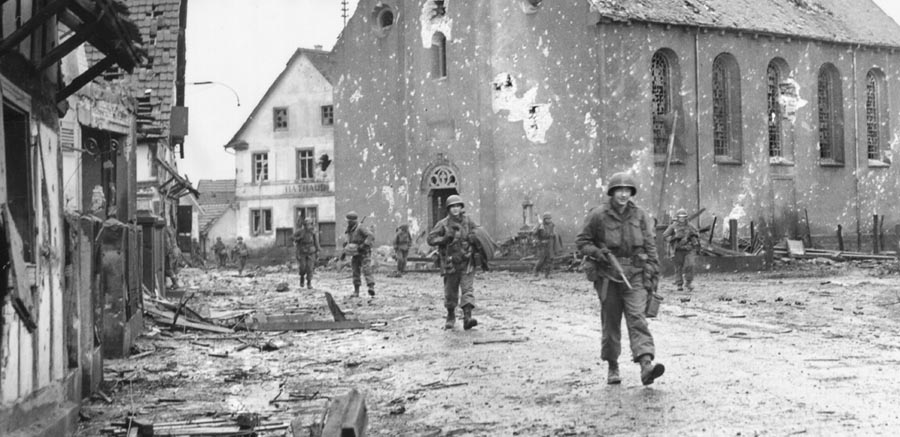
The 12th U.S. Armored Division, commanded by World War I veteran Maj. Gen. Roderick R. Allen, had arrived in France in mid-November, fought near Luneville and then Bitche in December. It had then gone into reserve before the Germans launched their Nordwind offensive.
Elements of the division were ordered to the town of Hochfelden on January 6 to support operations to wipe out the German Rhine bridgehead. It was to be a joint operation with French forces driving up from the south and the U.S. 79th Infantry Division “demonstrating” against Drusenheim in the north.
Herrlisheim, about four kilometers west of the Rhine and at the center of the bridgehead, was to be taken in a pincer movement. No one knew how difficult this operation would be.
The 12th was to use only one of its combat commands for the operation: Combat Command B (CCB), which included the 56th Armored Infantry Battalion and the 714th Tank Battalion, along with Company B, 119th Armored Engineer Battalion, and the 18 105mm howitzers of the 494th Armored Field Artillery Battalion in direct support. In preparation for the attack, the armored infantry of CCB moved in the early morning of January 8 to the town of Kurtzenhouse and the tanks to Weyersheim, west of Herrlisheim.
CCB, under Colonel Charles Bromley, was organized into two task forces. The 56th Armored Infantry Battalion (minus its Company C) with Company B, 714th Tank Battalion attached was designated Task Force Rammer, under Lt. Col. Louis L. Ingram. The 714th Tank Battalion, under Lt. Col. WiIIiam J. Phelan, with Company C, 56th, in place of its own Company B, was designated Task Force Power.
Both units were ordered to attack Herrlisheim from the north on January 8, jumping off from just west of Rohrwiller, at 10 am. Company L, 314th Infantry Regiment, 79th Infantry Division had secured a bridgehead across the Zorn at a small group of buildings, la Breymuhl, which contained machinery for regulating the flow of the river, referred to as “the waterworks.”
Between Rohrwiller and la Breymuhl were two footbridges over branches of the Moder, then a bridge over the Zorn just before la Breymuhl (where CCB was to pass through Company L/314’s lines), and a second bridge over Kleinbach Creek as it flowed through Herrlisheim. These features would all play important roles in the upcoming battle.
The planning was meticulous. At 8 am, TF Rammer moved out from Kurtzenhouse, followed by TF Power, which took the lead at Bischwiller with 17 M4 Shermans of Company C, 714th under Captain Charles C. Clayton.
Between Bischwiller and Oberhoffen the tanks swung east and then south to the main road, traveling 800 yards before deploying in attack formation in the snowy fields. Captain Clayton went forward on foot to check the line of departure—the first bridge, which his tanks would have to cross—and found the last planks being put in by the 40th Engineer Combat Regiment.
Captain Robert W. Harrington’s Company A, 714th followed Clayton’s tanks, less the detached 3rd Platoon, the 1st and 2nd Platoons continuing to Rohrwiller, where they secured the northern part of the town. Company D, 714th, with five M5A1 Stuart light tanks, reached Bischwiller about 9:30, and was assigned to evacuate the wounded and haul supplies.
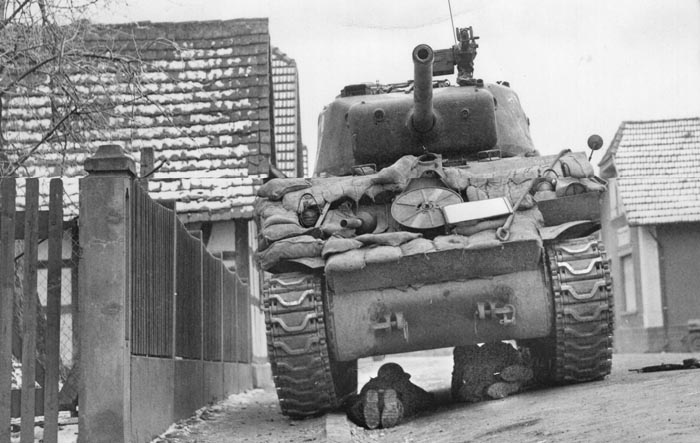
Captain David S. Fairbairn’s Company C, 56th, TF Power, overstrength with 251 officers and men, was to move east between Rohrwiller and Herrlisheim to protect the assault’s left flank. Once Herrlisheim was taken, Fairbairn was to pass east of the town, continue on to Offendorf, and meet the French advancing from Gambsheim.
The foot troops climbed onto Harrington’s and Clayton’s tanks at Weyersheim, with the antitank platoon’s half-tracks following. Upon reaching their assembly area, the infantry dismounted and organized for the attack.
Captain Burnett B. Beach’s Company B, 56th, understrength at 155 men, and with the Headquarters Company’s 28-man heavy machine-gun platoon attached, led TF Rammer in its half-tracks. Captain Clyde K. Maddox’s Headquarters Company, 56th, was bringing up the rear of TF Rammer but then moved in front at Bischwiller; its 11-man reconnaissance platoon reached Rohrwiller at 9 am.
The heavy mortar platoon led by 2nd Lt. Leo Mulligan—25 men with three 81mm mortars on M21 half-tracks—followed. Behind them was a 26-man assault gun platoon with three 75mm howitzers on M8 light tank chasses. The units were to reinforce the attack and provide “on-call” fire.
Maddox’s 56th Battalion’s HQ Company set up its command post in Rohrwiller. Captain Francis B. Drass’s Company A, 56th, followed Beach’s Company B with its 190 men, reaching Rohrwiller about 11 am. At approximately 2:30 the two companies jumped off. Rolling after Drass’s company, was Company B, 714th, with 17 Shermans, under Captain James W. Leehman.
In order for Clayton’s Company C, 714th to move east of Rohrwiller-Herrlisheim and clear that sector for the 56th’s drive, 2nd Lt. Wallace A. Russell’s 2nd Platoon of Company C, 56th moved forward to check the bridges, which the tanks would need. They reached the Bailey bridge across the Moder at 10:20 am just as the engineers completed work.
Russell radioed for the tanks and the remainder of Fairbairn’s Company C to move up, but as the 2nd Platoon approached la Breymuhl, it came under fire. When Russell reached the waterworks and found Company L, 314th Infantry defending, he discovered that the just-built Moder bridge had been destroyed.
At about 11:45, Fairbairn’s armored infantrymen came forward and located the waterworks keeper, asking if the water level could be lowered enough for tanks to cross. When told that it could be reduced by a meter where the Zorn River met the Moder, Fairbairn called for two tanks from Clayton’s Company C, 714th to attempt the crossing; only one managed to wade the river.
Fairbairn then directed Russell to lead a patrol to obtain prisoners. With five men, Russell captured six Germans. While returning, they drew fire; two men were killed and one was wounded. When they reached the outer wall of the waterworks courtyard, enemy fire increased. The prisoners made it into the courtyard with Russell, but two men with him were killed.
When two enlisted men were wounded, Captain Fairbairn rushed out to aid them but was hit in the shoulder. Lieutenant Russell, a medic, and another man, then made five trips with a stretcher to bring in the wounded as the Germans held their fire. Before being evacuated, Fairbairn directed 1st Lt. John E. Trusley, Anti-Tank Platoon leader, Company C, 56th to take command of the company.
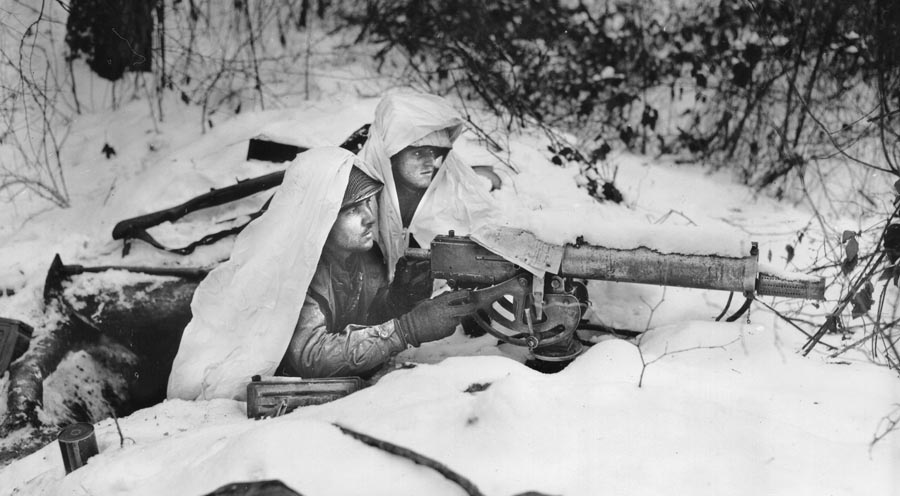
Since the bridge at the waterworks was out, preventing the tanks from moving with the infantry, Lt. Col. Phelan called Captains Harrington and Clayton and Lieutenant Trusley at 2:30 pm to give them the word that the 56th would attack without close armor support. The tanks of Companies A and C, 714th were to support by fire, assisted by the 714th’s four 105mm assault guns.
It was late in the afternoon when Clayton’s tanks began to move from la Breymuhl to positions west of Herrlisheim, facing the town, later joined by Harrington’s Company A. When darkness came, they pulled back.
Lieutenant Colonel Ingram, in command of TF Rammer, contacted Captain Leehman, Company B, 714th, and told him to bring his tanks from Bischwiller to Rohrwiller and then move as close as possible behind the dismounted Companies A and B, 56th. But when Leehman received word that the infantry was drawing fire, he deployed his tanks around la Breymuhl.
That afternoon, when Lieutenant Trusley, commanding Company C, 56th, found that the 2nd Platoon was holding la Breymuhl, he ordered the 3rd Platoon to advance from Rohrwiller to the waterworks to relieve Russell’s troops. They arrived there shortly after dusk.
Companies A and B, 56th were then to enter the waterworks, cross the Zorn, and continue to Herrlisheim abreast as darkness set in.
When Captain Beach, commanding Company B, 56th, was told that the two footbridges to be used were under mortar and artillery fire, he decided to rush a squad at a time across them, after which they would move off to the west side of the road to Herrlisheim, where a slight embankment offered some protection.
After 1st Platoon dashed across the second footbridge, mortar fire became intense, inflicting heavy casualties in the 2nd and 3rd Platoons.
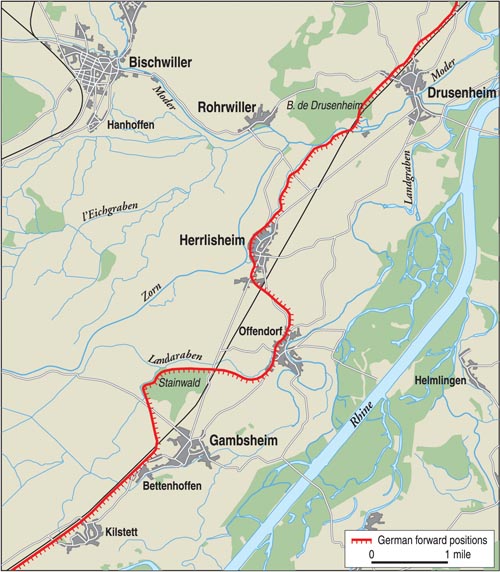
At 3 pm, Beach’s hard-hit Company B moved over the bridge at the waterworks and swung east into a nearby alleyway. Many of the personnel became confused as they found that 2nd Platoon of Company C, 56th, and Company L, 314th Infantry, occupied buildings there. The 1st Platoon was sent to the west side of the works to make room for the other platoons.
As this was taking place, the Germans unleashed a mortar barrage on la Breymuhl, wounding Captain Beach in the legs; 2nd Lt. John R. Casner, Jr., 2nd Platoon leader, briefly took charge of the company. After reorganizing, Company B moved out. When the 1st Platoon had almost reached Kleinbach Creek, it turned to the south going directly at Herrlisheim.
The 2nd Platoon moved abreast to the east with 3rd Platoon following. They paused briefly to let Company A catch up, then moved another 50 yards and dug in as darkness fell.
Drass’s Company A, 56th, left its dismount area at 3 pm and crossed the two footbridges. About 10 pm, the 2nd Platoon reached its assigned sector and deployed, while half of the 1st Platoon took positions behind it. The rest of Company A remained at la Breymuhl.
Company B, 56th, was finding the digging difficult in the frozen, snow-covered ground. Prior to the arrival of Company A, some of the men noticed a group of about 30 Germans moving toward them in the darkness across the flat ground, silhouetted against two burning buildings in Herrlisheim.
Staff Sergeant Charles F. Peischl, 1st Platoon, said, “They had no formation, were talking loudly, and suspected nothing because I could see the two leading men of the party—one with a burp gun on his shoulder and another with two boxes of ammunition—nonchalantly walking straight toward me.”
The Germans were so close that word could not be passed of their approach; however, all the GIs seemed to have sighted them about the same time, as they quickly stopped digging and silently took up firing positions. When Peischl noticed that the German with the ammunition boxes was slowly putting them down, possibly suspecting that something was amiss, Peischl opened fire.
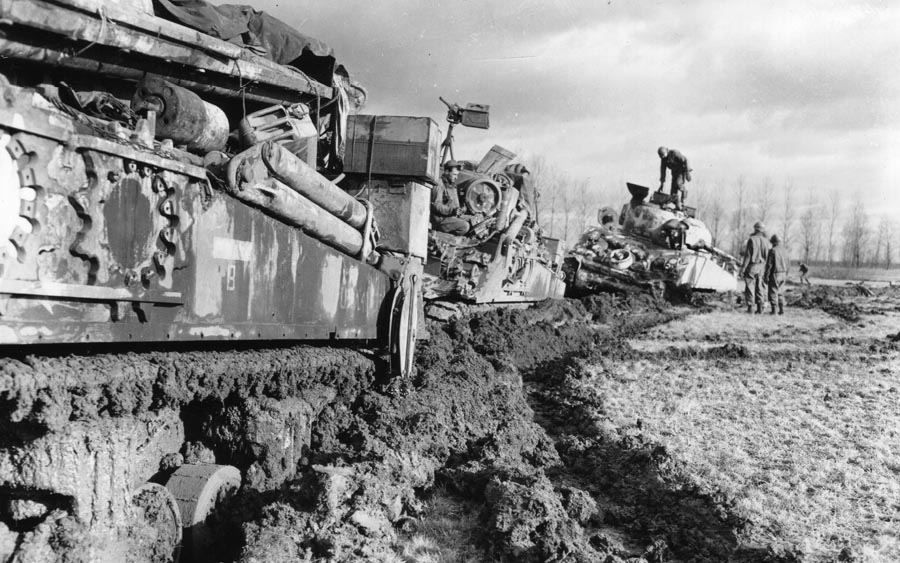
The entire company then let loose. Two light machine guns caught the Germans in a crossfire, while others heaved hand grenades and emptied their rifles. The Germans were so surprised that they were not able to get off a shot; some escaped but at least 12 were killed.
Around 1:30 am on January 9, word came for Companies A and B to return to the waterworks. There they set up security around the buildings and courtyard, overcrowded now with all three infantry companies of the 56th, plus Company L, 314th Infantry. A half-hour later, Lt. Col. Ingram sent 1st Lt. Floyd C. Vanderhoef, XO of Company A, 56th, to take charge of Company B, 56th, replacing Lieutenant Casner.
By the end of the first day, CCB’s attack had come up short, with its infantry and tanks holed up at la Breymuhl, then having to fight through the night. The commanders of both Companies B (Beach) and C (Fairbairn), 56th, had been wounded and replaced, and Company B had suffered heavy casualties. By nightfall there was still no bridge at la Breymuhl for the tanks to cross.
First Lieutenant Andrew J. Cavanaugh III, 56th Headquarters Company, Machine-Gun Platoon, recalled, “About 0330 all hell began to break loose at the waterworks.” The sound of approaching track-laying vehicles gave way to mortar shells landing in the courtyard. A group of Germans approached through an orchard to the east and began tossing concussion grenades over the wall, causing little damage. The GIs retaliated by lobbing grenades back and picked off Germans who ventured beyond the wall.
Two German panzers now came toward the waterworks and began to fire at the upper floor. Fortunately, the panzers were unable to lower their fire due to a seven-foot stone wall between them and the waterworks. One of the panzers moved to the west side of the courtyard and knocked down part of the building’s outer wall.
As their position was becoming untenable, Private Robert L. Scott volunteered to take a bazooka and knock out the panzer, but the weapon misfired. Undaunted, Scott ran back, picked up another, and returned. This time he hit the panzer and disabled it. The second tank then lumbered up, its crew attached cables, and pulled the disabled vehicle back toward Herrlisheim.
Fighting at the waterworks continued until daybreak.
During the night the American commanders prepared plans for a dawn attack on Herrlisheim. Company B, 56th, now under Lieutenant Vanderhoef, was to lead off at 6:05 am, to be followed 10 minutes later by Drass’s Company A coming abreast on B’s west flank. Both companies were to be at the edge of Herrlisheim by dawn, then clear the town with Company A on the left bank of the Kleinbach and Company B on the right. Company C would mop up.
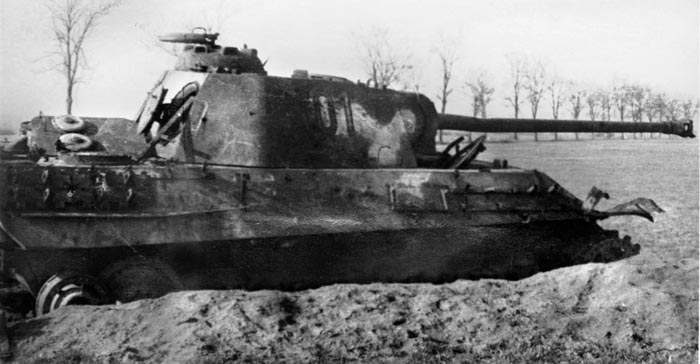
Lieutenant Colonel Ingram called Captain Leehman to Bischwiller at midnight to give him the plan for his tanks. At daylight they were to cross the Bailey bridge, which was to be ready at the waterworks, follow the infantry, and give close support. The other two medium tank companies were to be in fields west of Herrlisheim, providing fire support. In case the Bailey bridge was not finished, Company C was to cover the right flank from the west bank of the Zorn.
At 4 am, Leehman found that the bridge was still not in; no work had been done on it during the night due to the shelling and fighting at the waterworks. Four hours later, Leehman ordered all firing ceased as a large number of Germans came forward to surrender; 125 prisoners were taken.
The infantry jump-off time was moved from 6:05 to 7:30 am due to the situation at la Bremuhl. But when the troops failed to move out, Lt. Col. Ingram arrived and got the attack going at 10:30 as the tanks of Company B, 714th, advanced down the opposite side of the Zorn. Company B, 56th, moved out of the waterworks but had to wait for Drass’s Company A to come up on its flank.
As Company B was moving, a heavy mortar barrage rained down on its 2nd and 3rd Platoons, causing extremely heavy casualties. One of those was Lieutenant Vanderhoef.
The thinned ranks of Company B pushed forward and had reached the edge of Herrlisheim, where they were halted by machine-gun and small-arms fire coming from a clump of trees at the edge of town. To escape this hail of lead, the company veered to the southwest and then held up for a short time at the outskirts of the town.
As Company A moved out of the waterworks a few minutes after Company B, it was met by mortar, small-arms, and machine-gun fire but luckily suffered little. After they pulled alongside Company B’s west flank, the assault moved ahead. A little over halfway to Herrlisheim, Drass’s company pivoted to the southeast and entered the village.
They advanced against small-arms fire, intending to secure the northwest part of the town and continue south through the streets. After Companies A and B cleared out their sectors, they were to meet where Kleinbach Creek exited the town and await orders.
During the morning, the 3rd Platoon of Harrington’s Company A, 714th, rejoined the company on the left of the 2nd Platoon, relieved from its earlier attachment. Lt. Col. Phelan ordered it to move as close to the Zorn as possible to protect to the east and northeast. The platoon then spotted German machine guns and panzers that were firing on the infantry as they emerged from la Breymuhl.
The 1st and 2nd Platoons had moved down to the Zorn, west of the town, to provide direct fire into its southern half, which would be lifted as the infantry entered the town. “But the 3rd Platoon could not return the fire because Company B, 56th, was passing directly in front of us,” explained Captain Harrington, Company A, 714th.
Just prior to Harrington’s tankers moving down to fire into the town, Clayton’s Shermans had gone forward. Along with assault guns, the tanks blasted the town, gradually moving their fire down as Company B, 714th, neared.
At about 8:30 am, Drass’s men entered Herrlisheim. The first four intersections along the north-south road into Herrlisheim had been designated as phase lines. Upon reaching each line, Company A was to radio the battalion CP in Bischwiller but was unable to do so because its radios were not operating. Companies B and C were also having radio problems.
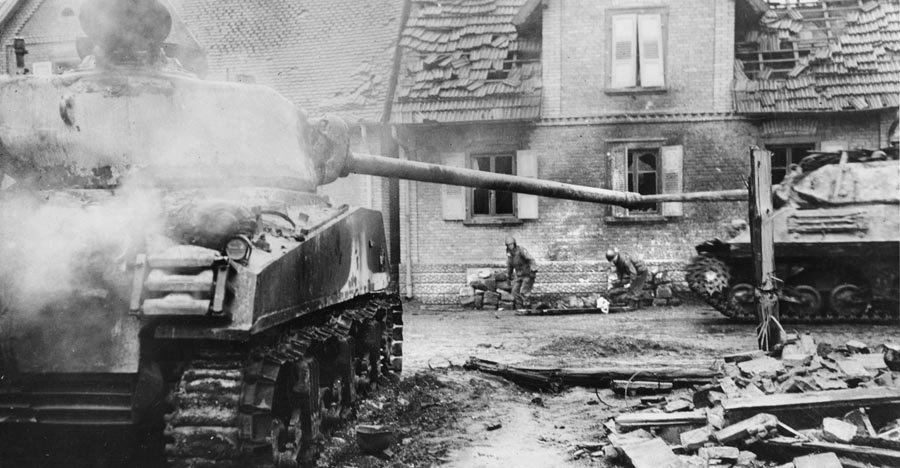
Company A began to move through Herrlisheim’s streets, clearing the houses. The 40-man 2nd Platoon led off, working from the westernmost north-south road toward the east. Company B was to fill the gap from there to Kleinbach Creek and along its opposite bank. The 1st Platoon, Company A, with 35 men, entered just below the 2nd, moved down the same road, but cleared in the opposite direction, to the west.
Drass’s troops hadn’t gone far when they encountered a Mark IV panzer; after a half hour the panzer withdrew. As the company began to move again, it was confronted by six German paratroopers and killed three.
The troops advanced by squads, one leapfrogging past the next as they cleared the houses. While a few men stood guard outside and others went to the rear to check the outhouses, the rest made a search of the rooms.
They kicked doors open and poked into basements and upper stories, capturing a few prisoners and discovering abandoned machine gun and antitank gun positions. The 3rd Platoon, with 19 men, followed the other two and mopped up, capturing 16 Germans in one cellar.
As Company A approached the bridge within the village, unknown to them a panzer sat on the opposite side of the stream with its main gun trained on the bridge. When the 1st Platoon reached the bridge, three men started across.
The first soldier reached the center of the bridge just as the panzer fired an high-explosive round and then finished him off with its machine gun; the other two men managed to crawl back to safety. The 2nd Platoon ran into heavy fire to its front and left flank as one man was killed and three were wounded.
At about 10:30, Leehman’s Company B, 714th, moved out from la Breymuhl to the west of Herrlisheim, keeping pace with the infantry on the other side of the Zorn, with the tank platoons firing to cover each other as they leapfrogged southward. When west of the town, they let loose with their machine guns at foxholes along the west bank of the Zorn and at a pillbox. About 25 Germans quickly surrendered, and the pillbox proved to be empty.
Company C, 56th, in reserve, moved from the waterworks about noon. The 1st Platoon, under Tech. Sgt. Lowell D. Huddleston, was to have its west flank guiding along the road from la Breymuhl; Lieutenant Russell’s 2nd Platoon was to follow the 3rd, under 2nd Lt. Gino A. Forchielli, as it advanced between the Zorn and the road.
Huddleston’s 1st Platoon moved quickly to get under cover just west of the road while 3rd Platoon came up “on the double” and moved abreast of the 1st, on its west flank. The company entered Herrlisheim at about 2:30 pm, having suffered only two casualties in spite of being subjected to intense fire, including nebelwerfer rockets.
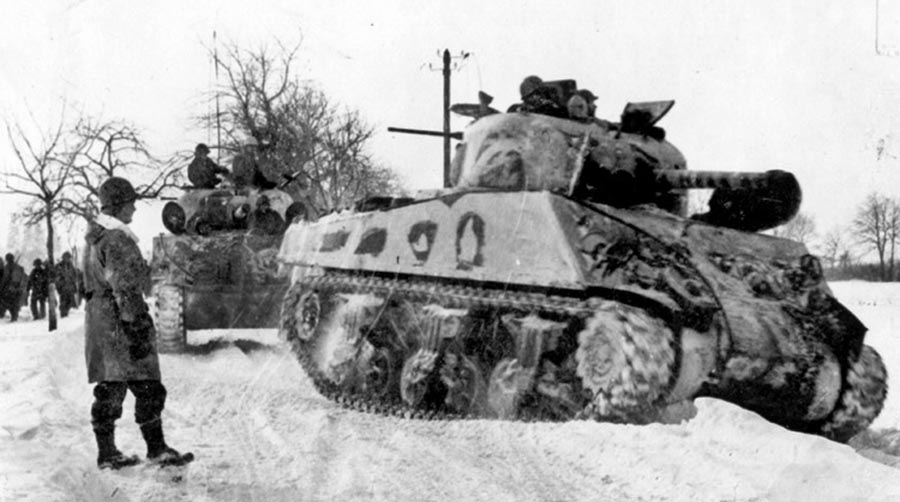
At about 4 pm, Captain Leehman found that the Bailey bridge at la Breymuhl was finally in place, so Lt. Col. Ingram ordered Leehman to move his Company B tanks over it and into Herrlisheim at once. The 1st Platoon was to hold its position and cover the 2nd and 3rd as they moved through the waterworks.
Leehman’s company encountered heavy fire as it started toward la Breymuhl. First Lieutenant Arthur D. Slote’s tank was hit and went up in flames, killing one crewman. A 3rd Platoon tank belonging to 2nd Lt. Charles M. Hisinger was knocked out and two of the crew killed. A third tank was hit and set on fire, but the crew escaped. A fourth was also hit. The fight was over in minutes.
When Leehman saw the condition of his platoons, he asked for and received permission to take them back to Rohrwiller to “straighten out.”
As darkness came, Company A’s and C’s tanks pulled back. During the night plans were formulated for Companies B and C, 714th, to attack Herrlisheim the following day.
Second Lieutenant John Patterson, Jr., 1st Platoon leader, dispatched a messenger to Captain Drass, Company A, 56th, reporting their situation, requesting ammunition, and calling for artillery fire on enemy strongpoints. Drass gave orders for Company A to withdraw to the vicinity of phase line No. 4, reorganize, and set up defenses. He intended to consolidate the battalion in the morning and then push through the town.
That morning, Company B, 56th, entered Herrlisheim about a half hour behind Company A after having been subjected to merciless mortar shelling that thinned its ranks to approximately 35 men. Lieutenant Casner, once again in charge of the company, gathered the survivors at the edge of town then proceeded to enter the northwest corner of Herrlisheim to begin clearing houses.
Sergeant Peischl reported, “As we advanced, the enemy ran down the creek southward like scared ducks, leaving their foxholes at the rear of the houses without their weapons.”
By about 3 pm, Company B had only its light machine-gun squad and a few riflemen left. Then German machine guns opened up, accompanied by mortars. One man was literally blown apart by a shell.
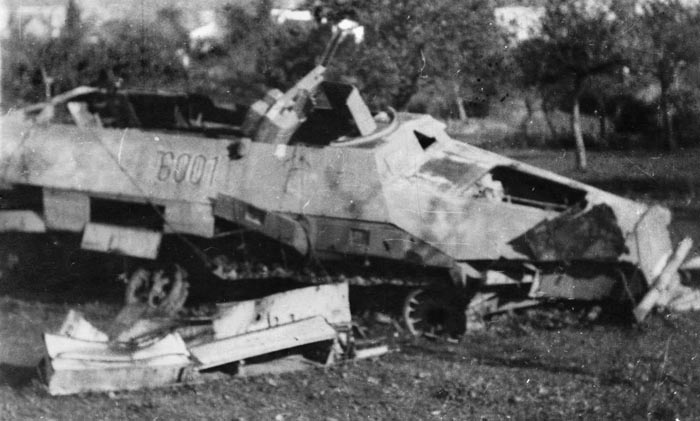
As the men were ready to push along the main road under 1st Lt. Henry Hilgert, 3rd Platoon, Lieutenant Casner came up. Seeing that he had just 20 men left, he ordered them to fall back, to be replaced by Company C.
As Company B moved into a house along the westernmost road that was thought to have been cleared, 36 German soldiers surrendered.
Near dusk, with communications to battalion having been lost, Lieutenants Casner and Trusley and Captain Drass—the latter now in charge of all the infantry in Herrlisheim—decided that Company B would hold in place and wait for morning.
Company B’s antitank platoon, which had been guarding the bridge near Rohrwiller, received word at 2 pm to move to Herrlisheim and reinforce Company B. The platoon was able to reach Company B’s CP without loss, nearly doubling the company’s strength as darkness was setting in.
In the meantime, German antitank guns fired on the 714th’s tanks in the open fields to the west, sending several up in flames. When Lieutenant Casner was badly wounded by mortar shrapnel, a lieutenant named Hilgert took command of Company B. The shelling let up after 7 pm as more Germans began infiltrating into the area.
Late that same afternoon, Company B, 119th Engineers, was told by Colonel Bromley to install a treadway bridge across the Zorn northwest of Herrlisheim. But when they arrived at the site they found the 714th’s tanks ablaze in the fields, lighting up the proposed bridge site in the growing darkness. Upon seeing the fires raging, the engineers turned back.
Throughout the night the situation of the beleaguered GIs in Herrlisheim became increasingly desperate. Cut off and without communications, they were subjected to German raids, some of which set fire to the houses. Orders were issued to shoot at anything that moved outside, and no one was to leave their position. Unopposed, German panzers roamed the streets and shot up houses at will.
“The Krauts seemed to have a system of first firing at a building with tracers to mark it,” Sergeant Peischl noted, “and then blowing it with a bazooka or AT gun. Some of them might have been doped up, for they would come right up to our doors, open them, and yell, ‘Komm heraus!’ We wasted no time in knocking them off.”
Luckily, Lieutenant Trusley’s Company C, 56th, had suffered little while moving from la Breymuhl into Herrlisheim, but his radio was knocked out.
Captain Drass met Trusley and told him that Company A had taken the first three streets—from phase lines No. 1 to 4. Since Company B was so badly shot up, Drass directed Trusley to take the left flank and advance along Kleinbach Creek until it was abreast of his own Company A, whereupon both companies would continue the advance to the south.
Four houses had to be cleared across the creek before Company C could work down—the 1st Platoon was chosen for the job. Several men were wounded by snipers, but the houses were cleared. At the same time, the 3rd Platoon cleared houses along the west edge of the creek.
Trusley contacted Drass, who directed that the company hold for the night at the positions it had taken on the battalion’s east flank and remain in contact with Company A to its south and Company B to its north.
At approximately 10:30 pm, Lt. Col. Ingram called 2nd Lt. John L. Jacobs, leader of 56th’s Headquarters reconnaissance platoon, and told him to take his 11 men into Herrlisheim and deliver two radios and the unit’s artillery overlay plans to Company A. He was to return with company strength reports.
Jacobs’ small force moved along the west side of the Zorn until they found a bridge they could use. As they stepped off the bridge, they encountered a dozen Germans, killing 10 and taking two prisoner. Under interrogation, the prisoners incorrectly reported that all the Americans who were in the town had been wiped out.
By this time, approximately 33 infantrymen who had escaped from Herrlisheim through the fields along the eastern bank of the Zorn joined Jacobs’ men. They reported that the town was cut off and surrounded and that it was impossible to advance further because the enemy troops had orders to shoot at anything that moved. This information, along with a blazing building that illuminated the ground they would have to traverse, persuaded Jacobs to abandon efforts to enter Herrlisheim.
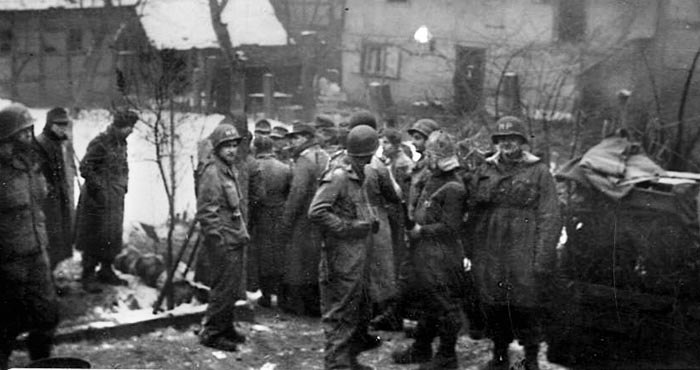
Jacobs then noticed colored lights moving in the fields to the north and east. The Germans appeared to be moving in.
Shortly after midnight, a Mark IV panzer approached Company A’s sector. The panzer shot up one house, but fortunately it was empty, then turned its attention on a 1st Platoon house next to the company CP. It pumped five rounds into it, but the occupants had gone to the cellar.
The panzer withdrew after an hour, but a group of 25 Germans who had accompanied it remained for a while before moving off. When one GI shouted out an inquiry as to what company was passing, the Germans scattered, but Browning machine guns opened up and cut them down.
By the end of the second day CCB had launched another assault on Herrlisheim. The Bailey bridge had been repaired, allowing the tanks to cross the Moder and advance to Herrlisheim. The start of the infantry attack had been delayed until 10:30, but then a mortar barrage had inflicted heavy casualties on Hilgert’s Company B, 56th, during its advance.
All three infantry companies had reached the town and begun clearing houses, then dug in after encountering German armor. But several Sherman tanks had been disabled and radio communications with the infantry were again out.
After Company B, 714th, had reorganized near Rohrwiller, Lt. Col. Ingram ordered Captain Leehman to move his company to Herrlisheim immediately. Leehman’s mission was to contact the infantry and have them withdraw. He started out at 4 am. So that his tanks did not lose contact in the darkness, they moved slowly in a tight formation. After crossing the Bailey bridge at the waterworks, they hugged the east bank of the Zorn.
As dawn broke, they entered the west end of Herrlisheim, and as Leehman reconnoitered, he spotted an enemy tank, which he knocked out with a point-blank shot. Leehman then encountered an American soldier who led him to Company A’s position, where he spoke to Captain Drass. Told that the infantry companies occupied only the northwest part of the town, he pulled his tanks up to that vicinity and radioed CCB that he had found the cut-off units. Headquarters told him to remain in place, but Leehman indicated that he thought that they could not hold the town.
At 6 am, Lieutenant Cook, in Oberhoffen, received word from Lt. Col. Ingram to take his light tanks to Rohrwiller, where he was to pick up the 56th Battalion’s Headquarters Company commander, Captain Maddox, and 19 infantrymen and take them to Herrlisheim, along with critical supplies.
Meanwhile, the engineers of Company B, 119th Engineers, were ordered to move down into Herrlisheim as infantry; CCB was running low on troops. With all three of its platoons at full strength—45 men each—the engineers started out from Oberhoffen in a column of trucks and half-tracks, then dismounted and traveled along the west side of the dry Augraben Creek. After a reconnaissance party found the damaged footbridge, they managed to cross despite the damage. Haze and mist allowed them to reach Herrlisheim safely.
The engineer platoons were placed at the southernmost point of the defensive perimeter. Foxholes were dug, minefields laid, and six medium tanks positioned to provide cover with bazooka teams protecting each.
When Cook reached the footbridge, he found that the Germans had attempted to destroy it; all that remained was a 15-foot-long stringer and railing, but enough to allow the men to cross one at a time. The infantry moved into the town at about 7:30 am under the cover of a thick fog. Cook returned to Rohrwiller.
At 8 am, Cook and his light tanks went forward again to the footbridge, this time transporting Lt. Col. Ingram and five of his men. A short distance beyond la Breymuhl, the column was slowed by enemy fire. Cook’s tank, the second in line, was hit. The crew jumped out unharmed except for the unfortunate driver, whose head had been blown off.
That was when Pfc. Wiseman jumped inside, started it, and backed it off the road to allow the rest of Cook’s tank column to continue on to Herrlisheim.
The light tanks brought in supplies to the beleaguered troops and evacuated the wounded under a thick fog. Captain Maddox contacted the three company commanders and found that there were approximately 50 wounded who required evacuation; the tanks made three trips to remove the wounded, but during their fourth trip, about 2 pm, they drew heavy antitank fire, which brought a halt to the operation.
Lieutenant Colonel Ingram arrived at 9:30 am to size up the situation and formulate plans to continue the attack. Trusley’s Company C was to cross Kleinbach Creek again, recapture the houses it had taken the day before, and come up on line with Drass’s Company A so that both could start a push to the south. Company B, badly weakened, was to stay in reserve. Company C was to jump off after noon.
Lieutenant Colonel Phelan had instructed Captain Harrington to take his tanks closer to the Zorn. They were to protect the movement of vehicles, supplies, and personnel into Herrlisheim and be prepared to resume the attack. Harrington’s Company A was also to cover the north and northeast part of the town, the roads leading into it from la Breymuhl and Drusenheim, and the railroad embankment. Harrington placed his tanks just south and west of the waterworks.
Meanwhile, Lt. Col. Ingram told Captain Maddox to move his mortars and assault guns nearer to the town to support the attack. When he learned of the heavy fire that the light tanks had drawn while traversing the road to la Breymuhl, he realized that he could not bring his M8 assault guns and mortar-carrying half-tracks over the same route. Instead, he had the mortars remain in place and sent his two assault guns to the field west of the Zorn to set up in defilade behind Augraben Creek.
The three ammunition and CP tracked vehicles with the assault guns crossed the frozen creek at approximately 2 pm, but the two M5 Stuarts broke through the ice and nosed down. Just then the Germans opened up with heavy antitank fire, presumably aimed at the tanks of Harrington’s Company A, 714th, which were in the field beyond the Zorn. Shells whizzed about as the half-tracks tried unsuccessfully to pull the M5s out of the stream.
When firing ceased, Maddox radioed to have a wrecker brought to Rohrwiller, where he would be waiting to guide it. It wasn’t until after dark that the wrecker was able to locate the M5s and pull them out.
After Clayton’s Company C, 714th, rolled into Herrlisheim early on January 9, and as the fog lifted, Phelan wanted Harrington’s tanks to pull back from their exposed position. About 3 pm, the tanks drew fire; luckily, there was only light damage to two. The tankers were then ordered to move farther west, the crews using smoke bombs to screen their withdrawal.
Under the cover of darkness, the 2nd and 3rd Platoons were brought northwest of Rohrwiller to replenish their ammunition and fuel. The 1st Platoon remained behind.
At 10:10 am, Lt. Col. Phelan visited Company C, 714th, with orders for Captain Clayton to take his tanks over the Bailey bridge and along the road leading into Herrlisheim from the north, to join the infantry in continuing the attack.
It was about 11 am when Clayton’s company crossed the bridge and moved forward just off the west side of the road, where the embankment offered some defilade. As they pulled onto the road in front of the town, all three 12th Armored Division Artillery battalions laid down a heavy smoke screen to the east.
As the tail of the column was entering the town, a Sergeant Phelps, commanding the next to last tank, spotted Germans manning an antitank gun at the northeast corner of the town. The Germans fired from several guns; the trailing American assault gun was knocked out, but the crew escaped.
The few American tanks still outside town moved quickly to get under cover, which they were able to do due to the fast thinking of the 1st Platoon leader, Lieutenant Dominic A. Dolce, as he advanced the head of the column to allow sufficient room for the rear of the column to get into the protection of the buildings.
After Lt. Col. Ingram reached Herrlisheim and plans had been made to continue the attack, Captain Leehman received word from Major Edward L Livaudais, S-3, 56th, to “sit tight,” as CCB was sending Lt. Col. Phelan down to take charge of operations; Phelan reached Herrlisheim at about 1 pm. Company C, 56th, was ready to jump off as Phelan decided the attack should begin at 2 pm and include the engineers and his tanks as support.
Battery C, 494th Armored Field Artillery Battalion, was to fire an artillery preparation prior to the assault on the north edge of the Steinwald Woods. At 1:45 they were to lay down a 15-minute concentration on the southern end of the town to “soften” it for the infantry advance.
Drass’s Company A, 56th, was to move down the westernmost street of Herrlisheim with Hilgert’s Company B following. Upon reaching the bridge over Kleinbach Creek, Hilgert was to cross over, join Trusley’s Company C, and work along the main road. Each company was to be supplied with two tanks from Leehman’s Company B, 714th, as support.
Once the drive got underway, Leehman planned to take the remainder of his tanks across the creek and place them at the eastern edge of town to protect Trusley’s Company C. As the attack pushed south, these tanks would keep pace, except for one platoon which was to remain behind as a covering force.
At the same time, Captain Clayton expected to send his 1st Platoon with Drass’s men along the west edge of town, the 2nd Platoon to remain at the northwest corner of town to cover the open field, and the 3rd Platoon to remain in place as a reserve.
The tempo of artillery and mortar fire now picked up until it reached a crescendo at about 1:40 pm, the same time that the 494th Armored Field Artillery Battalion’s concentration began to pound the Steinwald Woods.
By now the 56th AIB had been reduced to about 150 men as heavy concentrations of German fire steadily plastered the town.
At the CP, Phelan and the other officers organizing for the attack had to move several times to escape German shelling, fleeing from their CP building and ducking into the nearest house. A few minutes before the units were to jump off, at 2 pm, direct hits were scored on the house, blowing down the ceiling and injuring all the occupants. The wounded included Phelan, with a compound fracture of the leg and shrapnel in his back, and Lieutenant Dolce, whose intestines lay exposed.
The attack was not able to get underway due to the heavy infantry casualties and the steady stream of mortar and artillery shells, which lasted until dusk. The few men that Trusley had on hand attempted to get across Kleinbach Creek but were stopped cold along with the supporting tanks—hit by tank and antitank gunfire.
At 2:40 pm, Captain James M. Boone, S-3 of the 714th, who had arrived at Herrlisheim with Phelan, took command of the troops in the town by order of Major William B. Avery, S-3 of CCB, for the purpose of consolidating forces.
After determining the number of troops and conditions, Boone reported the situation to Major Avery. In addition, they determined that infantry reinforcements should be sent in immediately, feeling that that they could not hold their present positions if the Germans attacked in force that night. It was considered impossible to withdraw during daylight.
At around 4 pm, General Roderick Allen, division commander, ordered CCB to renew its attack but Colonel Bromley, the CCB commander, told Allen that his unit had suffered heavy casualties and was in no shape to attack. He proposed that the division simply contain the bridgehead and let the Germans wear themselves out trying to sustain it. Unaccustomed to having his orders challenged, Allen relieved Bromley of command.
Captains Boone and Drass and the other officers saw to the establishment of defensive positions for the night. The tanks were dispersed among the houses to cover the streets.
That night, while defenses were being established, General Allen decided Bromley was right and ordered CCB to pull all units out of Herrlisheim as soon as possible.
On Captain Boone’s order, the infantry companies were to move out in five-minute intervals. Each was to contribute a squad of six men with a machine gun to guard the area around the tank companies, Companies A and B, at the northwest corner of the town and Company C to the south. The tanks, in turn, were to cover the infantry as they withdrew and follow about an hour later when Boone gave them the green light.
Company B, 714th, would wait 10 minutes after the signal before pulling out, with Company C tying in behind. Three of Company B’s tanks were to be the last to leave. To keep noise to a minimum, tank engines were not to be started until the last moment. At that time the infantrymen, who had remained behind on outpost, were to depart.
A friendly artillery barrage came down on schedule; under its protection the troops began to withdraw. The three rifle companies moved off at approximately 1:30 am on January 11, but the night air was so thick with fog that the infantrymen had to hold on to one another’s belts as they moved in a column. The 3rd Platoon of engineers was the last to leave. The mist and bitter cold intensified the men’s suffering.
The infantry and engineer units reached the Zorn in less than an hour. Company A was the first to cross, followed by Company C and then B. The Germans were apparently unaware as the operation was completed without loss.
A half hour after the troops left the town, Boone gave the signal for the tanks to start their engines. They drew no fire on the way out.
Captain Leehman led his company along the east side of the Zorn with Boone behind, then Company C, and finally the rearguard tanks carrying the infantrymen who had remained behind to defend the tankers.
On the way out, Captain Clayton’s tank “quit” and had to be abandoned. The crew transferred to another tank, and both companies crossed over the Bailey bridge at la Breymuhl, continued on to Rohrwiller, and went into an assembly area northeast of Bischwiller.
The successful withdrawal was due in no small part to the artillery support. Shells were dropped at several points in and around the town. All three of the division’s artillery battalions fired concentrations, supplemented by units of the 33rd Field Artillery Brigade.
The initial assault on Herrlisheim had faltered due to failure to scout the terrain. While additional infantry might have helped, it’s doubtful that they could have gained much. There were also claims that the officers in charge were not sufficiently aggressive. The weather had also hindered operations, especially the ground fog that had reduced visibility and prevented aerial reconnaissance. Most serious of all, the Americans had underestimated their opponents.
By January 11, the Germans had increased the number of their troops at the bridgehead. At the same time, the battle for Hatten-Rittershoffen, two villages about 12-1/2 miles to the north, was underway; the Allies feared the Germans would try to enlarge the bridgehead by forming a junction with these forces.
While CCB, 12th Armored Division, had begun operations three days earlier at near full strength, the 56th Armored Infantry Battalion had taken heavy losses, including four wounded company commanders. Along with the 714th Tank Battalion, the two units were now mere shadows of their former selves, with little to show for their efforts.
But General Allen would not give up. On January 16, he committed CCA to remove the bridgehead. The renewed battle for Herrlisheim continued until January 19, with CCA now taking the brunt of the slugfest. It, too, fared no better than CCB; the result was a tactical draw, which led to a VI Corps grade for the 12th Armored Division of “unsatisfactory.”
In fact, the performance of the division at Herrlisheim was so criticized that an Iinspector General investigation of Allen was conducted. In the end, it concluded that he had done everything possible within the restrictions placed on him by higher headquarters—having been required to commit his units piecemeal while also keeping one combat command in corps reserve.
On January 19, the 36th Infantry Division relieved the battered 12th Armored at Herrlisheim. The 10th SS Panzer Division was pulled out, too, and used to face the 42nd Infantry Division at the Gambsheim bridgehead. Then it was withdrawn to Germany to try to stop the Soviets during the battle for Berlin.
Although the 12th Armored Division’s performance had been judged “unsatisfactory,” it had fought bravely and stopped the Germans from breaking out of the bridgehead and reaching either Strasbourg or the Colmar Pocket.
